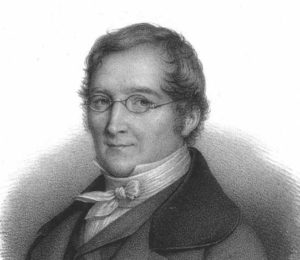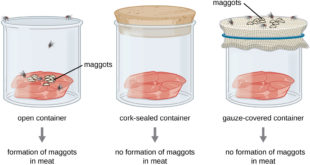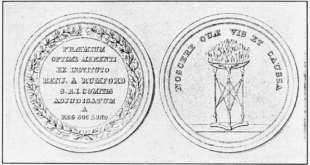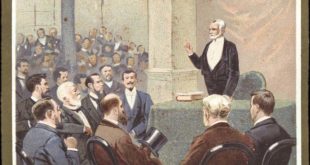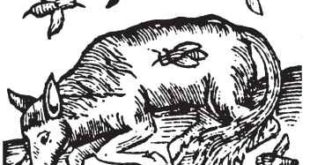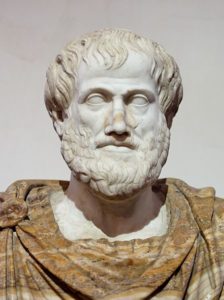
‘Scoop out a hole,’ said he again, ‘in a brick, put into it some sweet basil, crushed, lay a second brick upon the first so that the hole may be perfectly covered. Expose the two bricks to the sun, and at the end of a few days the smell of the sweet basil, acting as a ferment, will change the herb into real scorpions.
Redi’s Spontaneous Generation Experiment
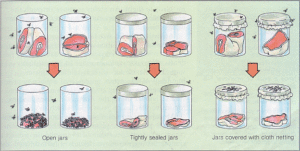
Buffon’s Spontaneous Generation Hypothesis
Buffon lent the authority of his name to the doctrine of spontaneous generation. He even devised a system to explain this hypothesis. In 1745 two ecclesiastics entered upon an eager controversy for and against this question. While the English Catholic priest Needham adopted the theory of spontaneous generation, the Italian priest Spallanzani energetically opposed it; but while in the eyes of the public the Italian remained master of the dispute, his success was more apparent than real, more in word than in deed.
The problem was again brought forward in a more emphatic manner in 1858. M. Pouchet, director of the Museum of Natural History at Eouen, in addressing the Academy of Sciences, declared that he had succeeded in demonstrating in a manner absolutely certain the existence of microscopic living organisms, which had come into the world without germs, and consequently without parents similar to themselves.
Louis Pasteur Enters the Spontaneous Generation Debate
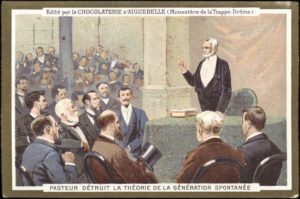
Thus the question as to the origin of microscopic organisms and the part played by them in fermentation was imposed as a necessity on Pasteur. He could not proceed further in his researches without having solved this question.
In the month of October, 1857, Pasteur was called to Paris. After having been made dean at an incredibly early age, he was now, at the age of thirty-five, entrusted with the scientific studies at the Ecole Normale Superieure. But if the position was flattering, it did not give to Pasteur what he most desired. As he had no Professor’s chair, he had no laboratory. In those days science, and the higher education in science, were at a discount. It was the period when Claude Bernard lived in a small damp laboratory, when M. Berthelot, though known through his great labours, was still nothing more than an assistant in the College de France.
Pasteur Establishes a Laboratory for Spontaneous Generation Research
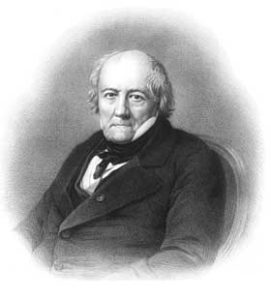
Bolder than M. Biot, but with a circumspection always alive, M. Dumas declared to Pasteur, without, however, further insisting upon the point, that he would not advise anyone to occupy himself too long with such a subject. M. de Senarmont alone took the part of Pasteur, and said to M. Biot:
‘Let Pasteur alone. If there is nothing to be found in the path which he has entered upon, do not be alarmed, he will not continue in it. But,’ added he, ‘I should be surprised if he found nothing in it.’
Pouchet and Heterogenesis
M. Pouchet had previously stated the problem with precision:
‘The opponents of spontaneous generation assert that the germs of microscopic organisms exist in the air, which transports them to a distance. What, then, will these opponents say if I succeed in inducing the generation of living organisms, while substituting artificial air for that of the atmosphere? ‘
Pouchet then devised this ingenious experiment. He filled a bottle with boiling water, hermetically sealed it with the greatest care, and plunged it upside down into a basin of mercury. When the water was quite cold he uncorked the bottle under the metal, and introduced into it half a liter of pure oxygen gas, which is as necessary to the life of the smallest microscopic organism as it is to that of the larger animals and vegetables. Up to this time there was nothing in the vessel but pure water and oxygen. Pouchet then introduced a minute bunch of hay which had been enclosed in a corked bottle, and exposed in a stove for a long time to a temperature of more than 100 degrees. At the end of eight days a mouldiness was developed in this infusion of hay. ‘Where does this come from? ‘ cried M. Pouchet triumphantly. Certainly not from the oxygen, which had been prepared from a chemical compound at the temperature of incandescence. The water had been equally deprived of germs, since at the boiling temperature all germs would have been destroyed. The hay also could not have contained them, for it had been taken from a stove heated to 100 degrees. As it was urged, however, that certain organisms could resist this temperature, M. Pouchet heated the hay from 200 to 300 degrees, or to any temperature that might be desired.
Pasteur came to disturb the triumph of M. Pouchet. In a lecture which he gave at the Sorbonne in 1864, before a large assembly composed of savants, philosophers, ladies, priests, and novelists Alexandre Dumas was in the first row all showing eager interest in the problems to be dealt with in the lecture, Pasteur thus criticized the experiment of Pouchet: ‘This experiment is irreproachable, but irreproachable only on those points which have attracted the attention of its author. I will demonstrate before you that there is a cause of error which M. Pouchet has not perceived, which he has not in the least suspected, which no one before him suspected, but which renders his experiment as completely illusory as that of Van Helmont’s pot of dirty linen. I will show you where the mice got in. I will prove to you, in short, that it is the mercury which carries the germs into the vessels, or, rather, not to go beyond the demonstrated fact, the dust which is suspended in the air.’
To render visible this floating dust, Pasteur caused the hall to be darkened, and pierced the obscurity by a beam of light. There then appeared, dancing and twirling in the beam, thousands of little particles of dust.
If we had time to examine them well,’ continued Pasteur, ‘we should see them, though agitated with various movements, falling downwards more or less quickly. It is thus that all objects become covered with dust the furniture, the table, the mercury in this basin. Since this mercury was taken from the mine, how much dust must have fallen upon it, to say nothing of all that has been intimately mixed up with it during the numerous manipulations to which it has been subjected in the laboratory? It is not possible to touch this mercury, to place the hand in it, or a bottle, without introducing into the interior of the basin the dust which lies on its surface. You will now see what takes place.’
Projecting, in the darkness, the beam of light upon the basin of mercury, the liquid metal shone forth with its usual brilliancy. Pasteur then sprinkled some dust upon the mercury, and, plunging a glass rod into it, the dust was seen to travel towards the spot where the rod entered the mercury, and to penetrate into the space between the glass and the metal.
‘Yes,’ exclaimed Pasteur with a voice which gave evidence of the sincerity of his conviction, ‘yes, M. Pouchet had removed the germs from the water and from the hay, but he had neglected to remove the dust from the surface of the mercury. This is the cause of his error; this is what has vitiated his whole arrangement.’
Pasteur then instituted experiments exactly similar to those of Pouchet, but taking care to remove every cause of error which had escaped the latter. He employed a glass bulb with a long neck, which he bent, and connected with a tube of platinum placed in a furnace, so that it could be heated nearly to redness. In the bulb he placed some very putrescible liquids urine for example. When the furnace which surrounded the platinum tube was in action, Pasteur boiled the liquid for some minutes, then he allowed it to cool, keeping the fire around the platinum tube still active. During the cooling of the bulb the external air was introduced, after having first travelled through the red-hot platinum tube. The liquid was thus placed in contact with air whose suspended germs were all burnt up.
In an experiment thus carried out, the urine remains unchanged it undergoes only a very slight oxidation, which darkens its color a little but it exhibits no kind of putrefaction. If it be desired to repeat this experiment with alkaline liquids, such as milk, the temperature must be raised a little above the boiling point a condition easily realized with the apparatus just described. It is only necessary to connect with the free extremity of the platinum tube a glass tube bent at right angles, and to plunge the latter to a depth of some centimeters into a basin of mercury. In these circumstances ebullition goes on under a pressure greater than that of the atmosphere, consequently at a temperature higher than 100 degrees Centigrade.
It remained, however, to be proved that the floating dust of the air embraces the germs of the lower organisms. Through a tube stopped with cotton wool, Pasteur, by means of an aspirator, drew ordinary air. In passing through the wool it was filtered, depositing therein all its dust. Taking a watch-glass, Pasteur placed on it a drop of water in which he steeped the cotton wool stopper and squeezed out of it, upon a glass slide, a drop of water which contained a portion of the intercepted dust. He repeated this process until he had extracted from the cotton nearly all the intercepted dust. The operation is simple and easily executed. Placing the glass slide with a little of the soiled liquid under a microscope, we can distinguish particles of soot, fragments of silk, scraps of wool, or of cotton. But, in the midst of this inanimate dust, living particles make their appearance that is to say, organisms belonging to the animal or vegetable kingdom, eggs of infusoria, and spores of cryptogams. Germs, animalculae, flakes of mildew, float in the atmosphere, ready to fall into any appropriate medium, and to develop themselves at a prodigious rate.
But are these apparently organized particles which are found thus associated with amorphous dust indeed the germs of microscopic living beings? Granting the experiment devised by Pasteur to verify that of Pouchet to be irreproachable, is Pasteur’s interpretation of it rigorously true? In presence of the problem of the origin of life, all hypotheses are possible as long as the truth has not been clearly revealed. Truly, it might be argued, if fermentation be caused by germs, then the air which has passed through a red-hot platinum tube cannot provoke fermentation, or putrefaction, or the formation of organisms, because the germs of these last, which were suspended in the air, have lost all vitality. But what right have you to speak of germs? How do you know that the previous existence of germs is necessary to the appearance and development of microscopic organisms? May not the prime mover of the life of microscopic organisms be some appropriate medium started into activity by magnetism, electricity, or even ozone? Now, by the passing of the air through your red-hot platinum tube these active powers are destroyed, and the sterility of your bulb of urine has nothing surprising in it.
The partisans of spontaneous generation had often employed this apparently formidable reasoning, and Pasteur thought it necessary to strengthen the proof that the cotton wool through which his air had filtered was really charged with germs.
By an ingenious method he sowed the contents of the cotton wool in the same liquids that had been rendered sterile by boiling. The liquids became fertile, even more fertile than if they had been exposed to the free contact of atmospheric air. Now, what was there in the dust contained in the cotton wool? Only amorphous particles of silk, cotton, starch; and, along with these, minute bodies which, by their transparency and their structure, were not to be distinguished from the germs of microscopic organisms. The presence of imponderable fluids could not here be pleaded.
Nevertheless, fearing that determined skepticism might still attribute to the cotton wool an influence of some sort on account of its being an organized substance, Pasteur substituted for the stoppers of cotton wool stoppers of asbestos previously heated to redness. The result was the same.
Pasteur’s Swan-Neck Flask Experiment
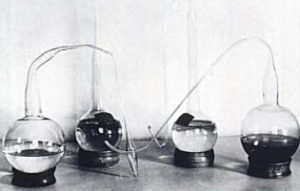
If, after remaining for weeks, months, or even years, in a heated chamber, the sinuous neck of the bulb is snipped off by a file in the vertical part of the stem, after twenty-four or forty-eight hours there begin to appear mildew, mucors, bacteria, infusoria, exactly as in the case of infusions recently exposed to the contact of ordinary air.
The same experiments may be repeated with slightly alkaline liquids, such as milk, the precaution being taken of raising them to a temperature higher than that of 100 degrees Centigrade.
The great interest of Pasteur’s method consists in its proving unanswerably that the origin of life, in infusions which have been heated to the boiling point, is solely due to the solid particles suspended in the air. Of gas, electricity, magnetism, ozone, things known or unknown, there is nothing in ordinary atmospheric air which, apart from these solid particles, can cause the fermentation or putrefaction of the infusions.
Lastly, to convince the most prejudiced minds, and to leave no contradiction standing, Pasteur showed one of these bulbs with the sinuous neck which he had prepared and preserved for months and years. The bulb was covered with dust. ‘Let us,’ said he, ‘take up a little of this outside dust on a bit of glass, porcelain, or platinum, and introduce it into the liquid; the following day you will find that the infusion, which up to this time remained perfectly clear, has become turbid, and that it behaves in the same manner as other infusions in contact with ordinary air.’
If the bulb be tilted so as to cause a little drop of the clear infusion to reach the extremity of the bent part of the neck where the dust particles are arrested, and if this drop be then allowed to trickle back into the infusion, the result is the same turbidity supervenes and the microscopic organisms are developed. Finally, if one of those bulbs which have stood the test of months and years without alteration be several times shaken violently, so that the external air shall rush into it, and if it be then placed once more in the stove, life will soon appear in it.
Spontaneus Generation Experiments: A Competition
In 1860 the Academy of Sciences had offered a prize, the conditions of which were stated in the following terms:
Even this proposition was soon improved upon, and it became a current opinion in science that the smallest bubble of oxygen or of air which might come in contact with a preserve would be sufficient to start its decomposition. The partisans of spontaneous generation the heterogenists thenceforward threw their objections to Pasteur into this form:
‘How can the germs of microscopic organisms be so numerous that even the smallest bubble of air contains germs capable of developing themselves in every organic infusion? If such were the case the air would be encumbered with organic germs.’ M. Pouchet said and wrote that they would form a thick fog, as dense as iron.
But Pasteur showed that the interpretation of Gay-Lussac’s experiment, with respect to the possible alteration of preserves by a small quantity of oxygen gas, was quite erroneous. If, after a certain time, an Appert preserve contains no oxygen, this is simply because the oxygen has been gradually absorbed by the substances of the preserve, which are always more or less chemically oxidisable. But in reality it is easy to find oxygen in these preserves. Pasteur did not fail to perceive that the interpretation given to Gay Lussac’s experiment was wrong in another particular. He proved the fallacy of the assumption that the smallest quantity of air was always capable of producing microscopic organisms.
More thickly spread in towns than in the country, the germs become fewer in proportion as they recede from human habitations. Mountains have fewer than plains, and at a certain height they are very rare.
Pasteur’s experiments to prove these facts were extremely simple. He took a series of bulbs of about a quarter of a liter in capacity, and, after having half filled the bulbs with a putrescible liquid, he drew out the necks by means of the blowpipe, then he caused the liquid to boil for some minutes, and during the ebullition, while the steam issued from the tapering ends of the bulbs, he sealed them with the lamp. Thus prepared, the bulbs can be easily transported. As they are empty of air that which they originally contained having been driven out with the steam when the sealed end of a bulb is broken off, the air rushes into the tube, carrying with it all the germs which this air holds in suspension. If it is closed again immediately afterwards by a flame, and if the vessels are then left to themselves, it is easy to recognize those in which a change occurs. Now, Pasteur established that, in whatever place the operation might be carried on, a certain number of bulbs would escape alteration. They must not, however, be opened in a room after dusting the furniture or sweeping the floor, for in this case all the bulbs would become altered because of the great quantity of germs raised by the dusting and remaining suspended in the air.
Pasteur started for Arbois with a series of bulbs. Some he opened in the country far from all habitations; others he opened at the foot of the mountains which form the first range of the Jura; a series of twenty four bulbs was opened upon Mount Poupet, at 850 meters above the level of the sea; and, lastly, twenty others were transported to the Montanvert, near the Mer de Glace, at an elevation of 2,000 meters. He afterwards brought his whole collection back to Paris, and in the month of November, 1860, deposited them on the table at the Academy of Sciences.
Of the twenty bulbs first opened in the country, eight contained organized productions. Of the twenty opened on the heights of the Jura, five only were altered, and of the twenty opened upon the Montanvert during a strong wind which blew from the glacier, one alone was altered.
If a similar series of experiments were made in a balloon, it would be found that the air of the higher atmosphere is absolutely free from germs. Care would, however, be necessary to prevent the introduction of dust particles, which the rigging and the aeronauts themselves might carry with them. But we have not yet related all. So far, all these conclusive experiments had been made only on organic liquids, very putrescible it is true, but which had all been subjected to boiling or even to temperatures higher than 100 degrees Centigrade. The partisans of spontaneous generation might then be justified in saying that if the precaution had been taken of putting into contact with pure air natural organic liquids in a state compatible with the operations of animal and vegetable life, the results would have been different. Under such conditions, life would have appeared spontaneously in the production of microscopic organisms. None of Pasteur’s opponents had formulated this argument; but Pasteur himself, who had within him an adversary always present, always on the alert, prepared to yield only to accumulated proofs, saw this objection. He was not satisfied until he had succeeded in completely refuting it. Having by means of ingenious “experimental arrangements deprived some air of all living germs, he placed in contact with this pure air the most putrescible liquids, particularly venous blood, arterial blood, and urine. He took these liquids directly from the veins, the arteries, and the bladders of animals in full health. No alteration was produced. In due time a chemical absorption of small quantities of oxygen took place, but neither fermentation nor putrefaction, nor the smallest development of bacteria, of vibrios, or of mould. After this, Pasteur was able legitimately to exclaim in his celebrated lecture at the Sorbonne:
‘There is not one circumstance known at the present day which justifies the assertion that microscopic organisms come into the world without germs or without parents like themselves. Those who maintain the contrary have been the dupes of illusions and of ill-conducted experiments, tainted with errors which they know not how either to perceive or to avoid. Spontaneous generation is a chimera.’
Pasteur was not alone in affirming this fixed conviction. With the authority of a judge delivering sentence in court, M. Flourens, permanent Secretary of the Academy of Sciences, pronounced these words before the whole Academy:
‘As long as my opinion was not formed I had nothing to say; now it is formed and I can speak. The experiments are decisive. If spontaneous generation be a fact, what is necessary for the production of animalculae? Air and putrescible liquids. Now Pasteur puts together air and putrescible liquids and nothing is produced. Spontaneous generation, then, has no existence. Those who still doubt have failed to grasp the question.’
But some adversaries remained incredulous. When Pasteur had announced the result of his experiments, and brought before the Academy his series of bulbs, Pouchet and Joly declared that if Pasteur had opened his bulbs in the Jura and on the Mer de Glace, they, on their part, had been on the top of the Maladetta, and had proved there the inexactitude of Pasteur’s results.
Pasteur asked to be judged by the Academy. ‘A commission alone,’ said he, ‘will terminate the debate.’ The commission was named, and the position on both sides was clearly stated.
‘I affirm,’ said Pasteur, ‘ that everywhere it is possible to take from the midst of the atmosphere a certain quantity of air which contains neither egg nor spore, and which does not produce organisms in putrescible solutions.’
On his side, M. Joly wrote: ‘If one alone of your bulbs remains unaltered we shall loyally acknowledge our defeat.’ Lastly, M. Pouchet, as distinct and positive as M. Pasteur, said: ‘I affirm that in whatever place I take a cubic decimeter of air, when this air is placed in contact with a fermentable liquid enclosed in a glass vessel hermetically scaled, the liquid will become filled with living organisms.’
This double declaration, which excited at that time all the learned world, took place in the month of January, 1864. Eager to engage in the combat, Pasteur waited impatiently for the order of the Commission that this experiment, which was to decide everything, should be made. But M. Pouchet begged for a postponement, desiring, he said, to wait for the warm season. Pasteur was astonished, but resigned himself to the delay. The Commission and the opponents met on June 15.
The Commission announced, ‘that, as the whole dispute turned upon one simple fact, one single experiment ought to be undertaken, which alone would close the discussion.’
Proponents of Spontaneous Generation Fail
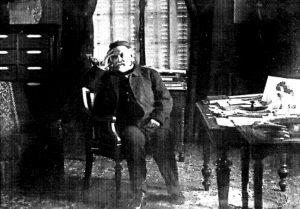
 Pasteur Brewing Louis Pasteur – Science, Health, and Brewing
Pasteur Brewing Louis Pasteur – Science, Health, and Brewing 